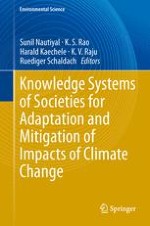2013 | OriginalPaper | Buchkapitel
Promoting and Enhancing Sustainable Livelihood Options as an Adaptive Strategy to Reduce Vulnerability and Increase Resilience to Climate Change Impact in the Central Himalaya
verfasst von : R. K. Maikhuri, L. S. Rawat, Sunil Nautiyal, Vikram S. Negi, D. S. Pharswan, P. Phondani
Erschienen in: Knowledge Systems of Societies for Adaptation and Mitigation of Impacts of Climate Change
Verlag: Springer Berlin Heidelberg
Aktivieren Sie unsere intelligente Suche, um passende Fachinhalte oder Patente zu finden.
Wählen Sie Textabschnitte aus um mit Künstlicher Intelligenz passenden Patente zu finden. powered by
Markieren Sie Textabschnitte, um KI-gestützt weitere passende Inhalte zu finden. powered by
